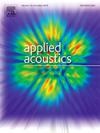Unraveling the specificity of auditory learning through vibrato perception
IF 3.4
2区 物理与天体物理
Q1 ACOUSTICS
引用次数: 0
Abstract
In the realm of auditory perception, the interplay between musical expertise and discrimination abilities remains a subject of ongoing investigation. This study delves into this complex relationship by investigating the impact of distinct musical backgrounds on the discrimination of vibrato attributes. Vibrato is a periodic variation in frequency and intensity, which is possible to produce in certain musical instruments (e.g. violin but not piano). The experiment engaged three distinct participant groups: musicians who are experienced in playing with vibrato (i.e., vibrato-musicians, n = 10), musicians who do not incorporate vibrato in their regular playing (i.e., non-vibrato musicians, n = 10), and non-musicians (n = 10). Discrimination thresholds were assessed using a three-interval, two-alternative, forced choice adaptive procedure. The tasks encompassed pure-tone frequency discrimination, employing 1000 Hz as the reference frequency, and vibrato-related discrimination tasks using 1000 Hz and 440 Hz as the carrier tones, modulated sinusoidally at 6 Hz. The findings reveal that while both musician groups surpass non-musicians in the frequency discrimination task, the advantage in vibrato-related discrimination was exclusively demonstrated by vibrato-musicians. This discrepancy underscores the selective influence of musical training on specific auditory attributes. By elucidating the nuanced interactions between musical training and auditory acuity, this research advances our understanding of the complex mechanisms underlying auditory expertise and lays the groundwork for tailored auditory training programs.
通过颤音感知揭示听觉学习的特殊性
在听觉感知领域,音乐专业知识和辨别能力之间的相互作用仍然是一个正在进行研究的主题。本研究通过研究不同的音乐背景对颤音属性辨别的影响,来探讨这种复杂的关系。颤音是频率和强度的周期性变化,在某些乐器中可能产生(例如小提琴而不是钢琴)。该实验涉及三个不同的参与者组:有颤音演奏经验的音乐家(即,颤音音乐家,n = 10),在常规演奏中不使用颤音的音乐家(即,非颤音音乐家,n = 10)和非音乐家(n = 10)。使用三间隔、两选择、强迫选择适应程序评估歧视阈值。这些任务包括以1000hz作为参考频率的纯音频率识别任务,以及以1000hz和440hz作为载波频率,以6hz正弦调制的振动相关识别任务。研究结果显示,虽然两组音乐家在频率识别任务中都超过了非音乐家,但颤音音乐家在颤音相关识别方面的优势仅被颤音音乐家所证明。这种差异强调了音乐训练对特定听觉属性的选择性影响。通过阐明音乐训练和听觉敏锐度之间微妙的相互作用,本研究促进了我们对听觉专业知识背后复杂机制的理解,并为量身定制的听觉训练计划奠定了基础。
本文章由计算机程序翻译,如有差异,请以英文原文为准。
求助全文
约1分钟内获得全文
求助全文
来源期刊

Applied Acoustics
物理-声学
CiteScore
7.40
自引率
11.80%
发文量
618
审稿时长
7.5 months
期刊介绍:
Since its launch in 1968, Applied Acoustics has been publishing high quality research papers providing state-of-the-art coverage of research findings for engineers and scientists involved in applications of acoustics in the widest sense.
Applied Acoustics looks not only at recent developments in the understanding of acoustics but also at ways of exploiting that understanding. The Journal aims to encourage the exchange of practical experience through publication and in so doing creates a fund of technological information that can be used for solving related problems. The presentation of information in graphical or tabular form is especially encouraged. If a report of a mathematical development is a necessary part of a paper it is important to ensure that it is there only as an integral part of a practical solution to a problem and is supported by data. Applied Acoustics encourages the exchange of practical experience in the following ways: • Complete Papers • Short Technical Notes • Review Articles; and thereby provides a wealth of technological information that can be used to solve related problems.
Manuscripts that address all fields of applications of acoustics ranging from medicine and NDT to the environment and buildings are welcome.
 求助内容:
求助内容: 应助结果提醒方式:
应助结果提醒方式:


